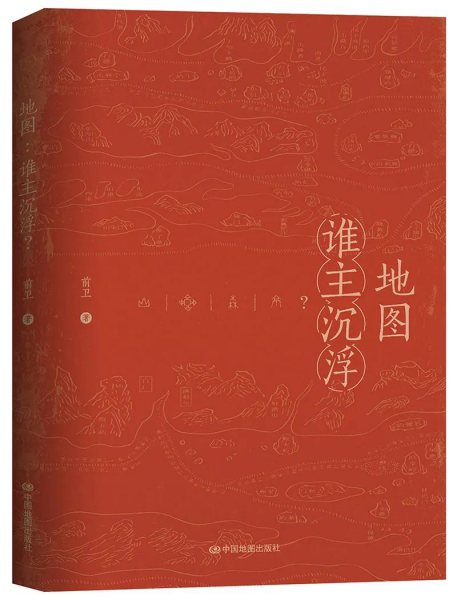Editor’s note: The geography and culture book “Map: Who Controls Ups and Downs”, written by Qianwei, a senior member of the cross-country e family, after ten years of searching historical materials and field exploration, can be called a journey through the history of Chinese geography and culture. In the book, there are wonderful descriptions of how the ancients made good use of maps to travel, fight wars, and govern the country. Recently, the book was officially launched and sold in major e-commerce and bookstores.
Ancient maps, from ancient times to the present, have witnessed the rise and fall of history, participated in the change of dynasties, recorded the vicissitudes of time, and also carried the dignity of the country and the process of national integration.
The wonder of the map is that there is no clear record of when it was born in the history books, but it has lived with the Chinese civilization and has never been separated.
The wonder of the map is that many mysteries with countless historical figures are inadvertently hidden in its lines and diagrams. So where did maps come from? Why was it born? Why are you excited?

The latest book “Map: Who Controls Ups and Downs” published by China Maps Publishing House? 》, taking historical time and space as the axis, taking important historical figures and major historical events as the outline, through the participation and witness of ancient maps in the historical process, introduces the past and present of ancient Chinese maps in more detail. The whole book starts from the Fuxi period of prehistoric legends and ends in the Republic of China. It is in the form of chapters. Each chapter selects the core figures and major events related to the map in a dynasty era. Explain the history of the development and evolution of maps. The whole book does not describe the development and changes of map surveying and cartography from a professional perspective, but focuses on the symbiosis and co-prosperity between maps and Chinese civilization. The whole book has both historical suspense interpretation and interesting reading.
Xia Yu made the Nine Tripods, Jing Ke assassinated the King of Qin, Zhang Song presented the map, Zheng He sailed to the West… How to connect these familiar historical stories with a main thread to make it fresher and more alive?
According to Zhou Qiang, a book reviewer, “Map: Who Controls Ups and Downs?” “Let us know the most numerous Chinese maps: For example, the earliest map of China’s political districts is Xia Yu’s “Jiuding Map”, the earliest military map is the Western Zhou Dynasty’s “Fighting Merchant Map”, and the earliest city map is Zhou Gong’s ” Luoyi map, the earliest plane map is the “Zhaoyu map” of the Zhongshan King’s Mausoleum in the Warring States Period, and the earliest atlas is the “Yugong area map” of the Western Jin Dynasty… And among the countless tops in China, there are many tops in the world most.
“Map: Who Controls Ups and Downs” can also be read as the history of the evolution of the Chinese nation: the Yellow Emperor “created characters, understood Sinan, and drew geographical mountains and rivers into graphics”, and formed an alliance with Emperor Yan, “the Huaxia people were formed from this”; A series of jaw-dropping reforms”, “Easy ethnic relations, and promote ethnic integration”; Shen Kuo in the Northern Song Dynasty was sent to Liao, and based on “the purity of folk customs and the orientation of human feelings” along the way, he wrote “Xining Envoy Khitan Picture Copy” , there is no lack of “North-South Change” between Han and Khitan in “Tu Chao”; until Sun Yat-sen proposed “Republic of Five Races”.
“Map: Who Controls Ups and Downs” also describes the history of China’s territorial changes: the Xia Dynasty’s vision of Kyushu, the Shang Dynasty’s eastern conquest, the Western Zhou Dynasty’s latitude and longitude, and the expansion of the Han Dynasty’s territory during the “peak era of Emperor Wu Liu Che”. In the era of Soochow, the sea territory finally had the name of the era. “Zhanghai” was originally the South China Sea, “Qidou” was originally the islands and reefs of the South China Sea, and “magnet” was originally the dark sand and hidden reefs in the Nansha Islands. The “Huang Yu Pan Pan Map” completed by Kangxi extends from Sakhalin Island in the northeast, Taiwan in the southeast, Ili River in the west, Beihai (Lake Baikal) in the north, Yazhou (Hainan Island) in the south, and west of Leh in the southwest. However, the vast area from the west of Hami to the Balkhash Lake and the unmeasured area in Tibet was a pity in the Kangxi era, which was supplemented and perfected in the “Qianlong Neifuhuang Tutu” in the Qianlong era.
China has a civilization history of 5,000 years, and a family history of more than 4,000 years. The emperor is the head of the family. Most of the chapters of “Map: Who Controls the Ups and Downs” are dominated by leaders of different eras. They love their home is love their country, although sometimes people will “hate” because of their “deep love”. Everything”. It is also love, and the love of the people is true love, true love. Mrs. Zhao of Eastern Wu, a woman who didn’t even keep her name, embroidered a map of “three mountains, five mountains, and cities in the world” only with “one embroidery needle and a few balls of colorful thread”. In the Peach Blossom Spring, Tao Yuanming looked at the “Shan Hai Jing Tu” and said, “If you look up to the universe, how can you not be happy again?” Looking at the map and admiring the great rivers and mountains, is there anything happier than this? Cheng Dachang was in the Southern Song Dynasty, looking forward to “Wang Shibei will set the Central Plains Day”, so he worked hard to draw the Guanzhong area that had been occupied by the Jin people into “Chang’an Map”…
The author of this book, Qianwei, is a senior geographer in China and a senior member of the cross-country e family. He has long focused on the study of the cultural history of ancient Chinese maps. He is the founder of Chinese Sanci. Served as the main contributor of the geographical and ecological program “Looking at China with Green Water and Green Mountains”. The humanistic history of ancient Chinese maps is like a legend with ups and downs in the author’s pen, supplemented by a series of rare ancient maps as illustrations, which makes this book reflect the essence of traditional books of “left picture right history”.
Maps have been a symbol of territory since ancient times, so they have been highly valued by rulers of all dynasties. Through the human history of the map, we can not only glimpse the ups and downs of history, but also look at the continuous inheritance and development of Chinese civilization from a different perspective. Records and legends about maps in China can be traced back to prehistoric times. “Chunqiu Zuozhuan” and other documents record the “Nine Tripod Maps” of the Xia Dynasty, and books such as “Book of Changes” also have records of “Hetu” and “Luotu”. However, due to the fragmented records and the loss of many physical maps that cannot be verified, the exploration of map human history is often unable to shine due to the limitations of these objective reasons.
“Map: Who Controls Ups and Downs?” “Refers to a large number of surviving ancient books and materials, and at the same time takes the archaeological discoveries as evidence, and tries its best to solve some contradictions in the records of ancient books. By capturing the moments most closely related to the map in history, the scene-style scroll slowly unfolds, allowing people to experience the role of witnesses and participants played by maps in history, which will help readers become more three-dimensional To understand the turbulent and glorious footprints of Chinese history.




